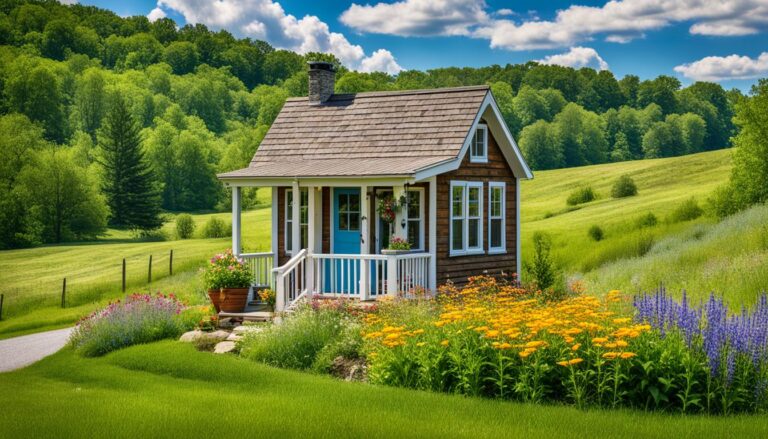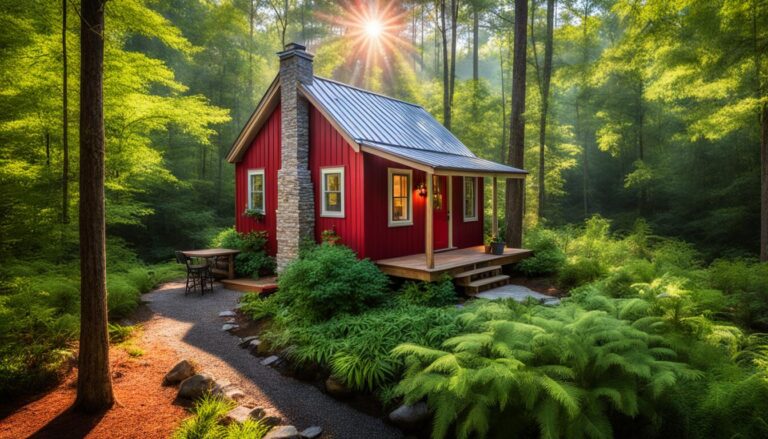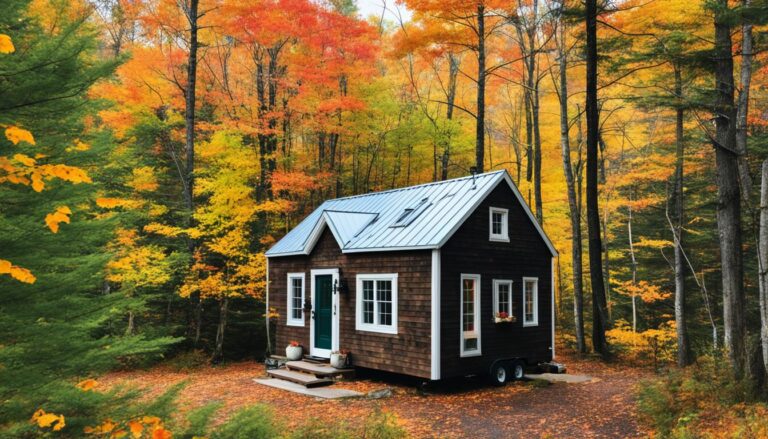Where Can I Put a Tiny House in Virginia? Location Guide
Did you know that Virginia has county-specific rules on small dwellings? If you’re considering living in a tiny house in Virginia, it’s crucial to understand the regulations that vary from one county to another. From tiny house zoning laws and building codes to land requirements and parking options, navigating the legal landscape can be overwhelming. However, with the right information in hand, you can find the perfect location to put your tiny house in the beautiful state of Virginia.
Key Takeaways:
- Virginia has county-specific rules for tiny houses, with varying levels of permissiveness.
- Some counties allow tiny houses on wheels (THOWs) on private land, while others may prohibit them.
- Fauquier County requires tiny houses to meet state construction regulations and be on a permanent foundation.
- Zoning laws in Virginia dictate how land can be used for development and habitation.
- Researching and understanding the regulations of your desired location is essential for building and living in a tiny house.
Are Tiny Houses Legal in Virginia?
When it comes to the legality of tiny houses in Virginia, there are no statewide laws that specifically govern them. Instead, the legality of tiny houses is determined by various factors, including building codes, zoning regulations, and local ordinances.
Building codes, such as the International Residential Code (IRC), provide guidelines for safety and construction standards that must be followed when building a tiny house in Virginia. These codes ensure that the structure meets certain requirements to ensure the safety and well-being of its occupants.
“Virginia does not have statewide laws governing the legality of tiny houses.”
Zoning regulations, on the other hand, vary by city, county, or town and dictate where tiny houses can be placed. Each jurisdiction may have different requirements and restrictions, so it’s important to research and understand the specific regulations in your desired location before embarking on a tiny house project.
Local ordinances can also come into play, further influencing the legality of tiny homes in Virginia. These ordinances may address issues such as minimum square footage, setbacks from property lines, or even the distinction between a permanent dwelling and a temporary structure.
It’s crucial to do your due diligence and become familiar with the regulations and requirements in your specific location to ensure that your tiny house is compliant with the law. Consulting with local planning or zoning departments can provide valuable information and guidance throughout the process.
What Kind of Tiny Houses Are Permitted in Virginia?
When it comes to tiny houses, Virginia offers a range of possibilities. You can choose from various types of tiny homes that are permitted in the state, including tiny houses on wheels (THOWs), backyard cottages, accessory dwelling units (ADUs), and stand-alone homes.
However, it’s important to note that the specific types of tiny homes permitted may vary depending on the location and its regulations. Some cities and counties in Virginia may have restrictions on the size, parking, and occupancy of THOWs. It is crucial to review the local zoning laws to determine the specific types of tiny homes allowed in your desired jurisdiction.
If you are considering a tiny house on wheels (THOW), be aware that some counties might have certain restrictions in place. These restrictions might include maximum size limits, required parking spaces, or specific rules regarding temporary or permanent residency in a THOW.
On the other hand, if you are looking to build a tiny house on a foundation, you will need to comply with the same building codes and regulations as larger homes in Virginia. These regulations typically cover aspects such as minimum square footage, room height, emergency exits, and foundation type.
Before embarking on your tiny house journey, it’s always wise to consult with local authorities and review the specific regulations and requirements applicable to your desired location. This will ensure that you stay within the boundaries of Virginia’s tiny house regulations and can build the perfect tiny home that meets your needs and dreams.
In summary, whether you opt for a THOW or a foundation-based tiny home, exploring the types of tiny houses permitted in Virginia is an exciting endeavor. Just make sure to do your due diligence, understand the local regulations, and consult with the relevant authorities to ensure a smooth and legally compliant tiny house journey.
What Does a Tiny House Need to Be Up to Virginia Building Codes?
To ensure that your tiny house complies with Virginia building codes, there are certain requirements that must be met. For permanent structures, such as tiny houses on foundations, the Virginia Residential Code and the International Residential Code (IRC) provide guidelines that include minimum square footage, room height, and specific requirements for windows and closets. These regulations are in place to ensure the safety and livability of the structure.
If you’re considering a tiny house on wheels (THOW), there are additional regulations to consider. Depending on the county, there may be parking restrictions and limitations on the duration of stay for THOWs. It’s important to familiarize yourself with the specific regulations of your desired location to ensure compliance.
In the case of transitional structures like accessory dwelling units (ADUs), utility connections and safety equipment may be required to meet Virginia building codes. Each type of tiny house structure has its own set of regulations that must be followed to ensure compliance with Virginia’s building codes and construction regulations.
By adhering to these requirements, you can ensure that your tiny house meets the necessary standards for safety and functionality. Being knowledgeable about Virginia’s building codes and construction regulations is essential to successfully build and enjoy your tiny house.
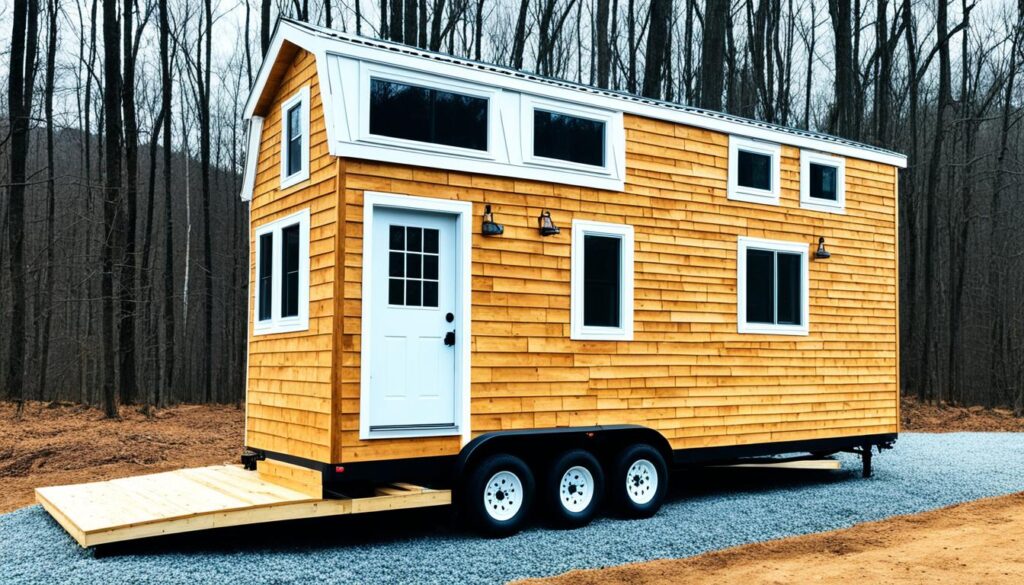
What Virginia Counties Allow Tiny Houses?
When it comes to building a tiny house in Virginia, it’s important to know which counties are more accommodating. Luckily, many counties in Virginia are considered tiny house-friendly and allow the construction of these small dwellings. However, it’s essential to note that the rules and regulations can vary from one county to another.
Some of the most tiny house-friendly counties in Virginia include Loudoun County, Spotsylvania County, Clarke County, Roanoke County, Henrico County, and Richmond City. These counties have embraced the tiny house movement and have regulations in place that permit the construction of tiny homes.
However, it’s crucial to understand that each county may have specific regulations and requirements for tiny homes. To ensure compliance with local laws, it’s advisable to consult with the planning or zoning departments of the desired county. They can provide you with detailed information regarding the regulations you need to follow when building a tiny house in that particular county.
By being aware of the tiny house-friendly counties in Virginia and understanding the regulations in place, you can make informed decisions and proceed with your tiny house project with confidence.
Can You Permanently Live in a Tiny House in Virginia?
Living permanently in a tiny house in Virginia is indeed possible, offering a unique and minimalist lifestyle. However, it is important to consider the local regulations and building requirements before making the decision to establish Virginia as your tiny house residency.
In certain jurisdictions, Virginia allows tiny homes to be designated as permanent dwellings, whether they are on wheels (THOWs) or foundations, subject to the approval of local building departments. These regulations can vary between counties and municipalities, which is why it is crucial to thoroughly research and understand the specific regulations and requirements of your desired location.
By complying with the local regulations, you can enjoy the benefits of living permanently in a tiny house in Virginia. Whether you choose to settle down in a THOW or a foundation-based tiny home, the sense of freedom, financial independence, and reduced environmental footprint can greatly enhance your living experience.
Living in a tiny house allows you to simplify your life, focus on experiences rather than material possessions, and embrace a more environmentally conscious lifestyle. It provides the opportunity to live mortgage-free and decrease your carbon footprint by utilizing sustainable resources.
However, it is crucial to remember that each location in Virginia may have its own set of regulations and restrictions. Some areas may require minimum square footage, utility connections, specific foundation types, or even limitations on the number of residents. By understanding and complying with these regulations, you can ensure a smooth transition into your new tiny house lifestyle.
In conclusion, living permanently in a tiny house in Virginia is a possibility, allowing you to embrace a simpler and more sustainable way of life. It is essential to conduct thorough research and understand the local regulations and requirements before making the decision to establish your tiny house residency in Virginia. By doing so, you can enjoy the freedom and benefits of tiny house living while complying with the regulations designed to ensure safety and harmony within the community.
How Tiny Can a House Be in Virginia?
When it comes to tiny houses in Virginia, there are specific size requirements that must be met. The land where the tiny house is located needs to be at least 320 square feet in size, providing enough space for the structure to be placed comfortably. As for the tiny house itself, it should have a square footage ranging between 120 and 400 square feet. This range allows for flexibility in design while ensuring that the house remains compact and efficient.
These size requirements may vary depending on the location and type of tiny house you want to build. To ensure compliance with Virginia’s building codes and regulations, it is important to consult the specific requirements of the desired location. This will help you determine the minimum and maximum size allowed for your tiny house project.
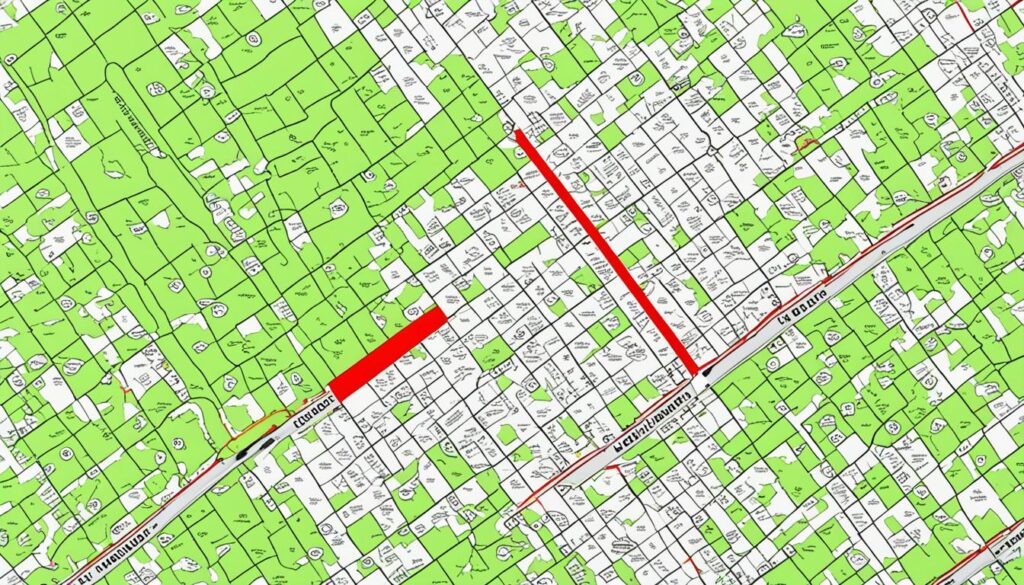
In addition to size requirements, there are other regulations that must be considered when building a tiny house in Virginia. Accessible rooms in tiny houses must have a minimum height of 6’8″ to ensure comfortable accessibility for all occupants. Furthermore, at least one room in the tiny house must have both a closet and a window. These requirements contribute to the functionality and livability of the space.
Virginia also requires tiny houses to be placed on a permanent foundation, such as piers or a concrete slab. This ensures stability and durability for the structure. Additionally, tiny houses need to comply with IRC-approved standard emergency exits and rescue apertures to prioritize safety in case of any unforeseen emergencies.
While tiny houses on wheels (THOWs) are allowed in Virginia, they are classified as temporary buildings. THOWs in Virginia must have an area of less than 400 square feet to be registered as recreational vehicles. It is important to note that local laws and ordinances may vary, so checking with the specific jurisdiction is necessary to understand any additional requirements or restrictions.
Virginia follows a decentralized approach to tiny homes, with local laws and ordinances varying by county. Different types of tiny house structures, including backyard cottages, accessory dwelling units (ADUs), RVs, tiny houses on wheels, and independent residences on private property, are allowed in the state. However, adherence to Virginia’s tiny house regulations is crucial to ensure compliance with building and zoning laws.
Overall, the size requirements for tiny houses in Virginia provide guidelines for creating compact living spaces that are functional and efficient. Understanding and complying with these regulations will help ensure a successful and legally compliant construction project.
Where Can I Build a Tiny House in Virginia?
When it comes to building a tiny house in Virginia, there are several options available depending on the regulations and requirements of specific counties. Whether you’re looking to settle in a residential zone, a rural or agricultural area, a mobile home park, or even build in your own backyard as an accessory dwelling unit (ADU), Virginia offers diverse opportunities for tiny house living.
Each location, however, may have its own set of regulations and requirements that must be followed. It is crucial to consult with the planning or zoning departments of your desired location to ensure compliance and legality. They will provide you with the necessary information regarding land use, construction permits, and any additional guidelines specific to that area.
One option for tiny house enthusiasts in Virginia are cooperative communities or cohousing developments. These communities often have supportive frameworks in place to facilitate the establishment of tiny houses and foster a sense of community among residents. Researching and connecting with existing tiny house communities in Virginia, such as Piedmont Ecovillage, Autumn Sun Farm, and Surfside at Sandbridge, can provide valuable insights and networking opportunities for finding suitable build locations.
Regardless of where you choose to build your tiny house in Virginia, it is essential to comply with all applicable regulations to ensure a smooth and legal construction process. By working closely with local authorities and following the guidelines set forth by each county and city, you can turn your dream of owning a tiny house into a reality.
Virginia Tiny House Communities
“Building a tiny house in Virginia offers the opportunity to be part of unique communities that embrace the tiny living movement. From cooperative villages promoting sustainability and shared resources to peaceful farm retreats, these communities provide a supportive environment for tiny house owners.”
When considering where to build your tiny house, exploring existing communities can be inspiring and provide guidance. Virginia is home to several notable tiny house communities, such as:
- Piedmont Ecovillage: Located in Louisa County, this community focuses on sustainable living and organic farming.
- Autumn Sun Farm: Situated in Virginia Beach, this farm community emphasizes environmentally friendly practices and holistic living.
- Surfside at Sandbridge: Found within the Sandbridge Beach area near Virginia Beach, this coastal community provides a unique tiny house living experience.
These communities offer opportunities to connect with like-minded individuals, share resources, and enjoy the benefits of tiny house living in a supportive environment.
Whether you choose to build your tiny house in an existing community or on private land, consulting with local authorities and researching the specific regulations and requirements of your desired location is crucial. By doing your due diligence and following the guidelines, you can embark on your tiny house journey with confidence in Virginia.
Where Can I Park a Tiny House on Wheels in Virginia?
When it comes to parking options for a tiny house on wheels (THOW) in Virginia, it’s important to understand that regulations may vary depending on the county. While THOWs are allowed in some counties on private land or backyards, others may have restrictions on parking locations. Generally, THOWs are not allowed to be parked in commercial parking lots or public areas.
In Fauquier County, for example, THOWs are not allowed as principal residences. However, in Buckingham County, THOWs are legal on private land and backyards, and off-grid toilets like composters can be used.
To ensure compliance with local regulations, it’s crucial to research the specific rules and regulations of the desired county in Virginia. This will help determine where a THOW can be legally parked and provide peace of mind when it comes to the legality and safety of your tiny house.
For more detailed information on parking options and regulations for tiny houses in Virginia, you can visit the Great Lakes Tiny Homes website. They are an RVIA-certified builder in Virginia and offer a variety of tiny houses that comply with strict safety and construction regulations.
Remember, local rules and regulations may vary, so it’s important to adhere to Virginia’s tiny house regulations to ensure legality and safety.
Conclusion
Building and living in a tiny house in Virginia requires careful consideration of the rules and regulations specific to each location. Virginia’s decentralized approach to tiny homes means that local and county laws may differ, making it essential for potential residents to research and become familiar with all relevant building and zoning rules before proceeding.
While Virginia does not have statewide laws governing the legality of tiny houses, it allows a broad range of tiny house structures, including backyard cottages, accessory dwelling units (ADUs), RVs, camper vans, tiny houses on wheels (THOWs), and independent residences. However, specific regulations and requirements may vary depending on the county and type of tiny home.
Compliance with Virginia building codes, size requirements, and utility connections is essential for legally constructing a tiny house. Tiny houses in Virginia should be on a permanent foundation, such as piers or a concrete slab, and feature IRC-approved standard emergency exits and rescue apertures. THOWs can be parked in Virginia, but not in commercial parking lots or public areas, and must be connected to power, water, and sewage.
Virginia’s acceptance of tiny houses as an alternative to traditional housing options reflects the rising popularity of minimalist living. To navigate the regulations and successfully build and live in a tiny house in Virginia, individuals should thoroughly research and understand the specific rules and guidelines of their desired location.
FAQ
Where can I put a tiny house in Virginia?
The location where you can put a tiny house in Virginia depends on the specific regulations of each county. Different counties have different rules regarding tiny houses, so it is important to research and understand the zoning laws and building codes of your desired location. Some counties allow tiny houses on private land, backyards, residential zones, rural areas, mobile home parks, accessory dwelling units (ADUs), and cooperative communities or cohousing developments.
Are tiny houses legal in Virginia?
Virginia does not have statewide laws governing the legality of tiny houses. The legality of tiny houses in Virginia is determined by local regulations, building codes, zoning laws, and local ordinances. It is essential to research and comply with the specific regulations of the desired location before building or occupying a tiny house in Virginia.
What kind of tiny houses are permitted in Virginia?
Virginia allows various types of tiny houses, including tiny houses on wheels (THOWs), backyard cottages, accessory dwelling units (ADUs), and stand-alone homes. However, the types of tiny houses permitted may vary depending on the location and its regulations. Each county or jurisdiction may have specific restrictions on size, parking, and occupancy for different types of tiny houses.
What does a tiny house need to be up to Virginia building codes?
To comply with Virginia building codes, tiny houses, whether on wheels or foundations, must meet certain requirements. Permanent structures must adhere to the Virginia Residential Code and International Residential Code (IRC) guidelines, including minimum square footage, room height, window requirements, and foundation type. Temporary structures like THOWs may have additional regulations regarding parking restrictions and duration of stay. It is important to review the specific building codes and regulations of the desired location to ensure compliance.
What Virginia counties allow tiny houses?
Many counties in Virginia are tiny house-friendly and permit the construction of tiny homes. Some of the most tiny house-friendly counties in Virginia include Loudoun County, Spotsylvania County, Clarke County, Roanoke County, Henrico County, and Richmond City. However, each county may have its own regulations and requirements for tiny homes, so it is necessary to consult with the planning or zoning departments of the desired county to ensure compliance.
Can you permanently live in a tiny house in Virginia?
Yes, it is possible to permanently live in a tiny house in Virginia. However, it is necessary to comply with local regulations and obtain approval from the building department. Some jurisdictions may allow tiny homes as permanent dwellings on wheels (THOWs) or foundations, while others may have restrictions. Researching and understanding the specific regulations and requirements of the desired location is crucial to determine if permanent residency in a tiny house is allowed.
How tiny can a house be in Virginia?
To be classified as a tiny house in Virginia, the home must meet certain size requirements. The land where the tiny house is located must be at least 320 square feet in area. The tiny house itself must have an area between 120 and 400 square feet. Specific size requirements may vary depending on the location and type of tiny house. It is important to consult the building codes and regulations of the desired location to ensure compliance with the size requirements.
Where can I build a tiny house in Virginia?
Tiny houses can be built in various locations in Virginia, depending on the regulations of specific counties. Possible locations for building a tiny house in Virginia include residential zones, rural or agricultural areas, mobile home parks, backyard ADUs, and cooperative communities or cohousing developments. However, each location may have specific regulations and requirements that must be followed. Consulting with the planning or zoning departments of the desired location is essential to determine where a tiny house can be legally built.
Where can I park a tiny house on wheels in Virginia?
The parking options for a tiny house on wheels (THOW) in Virginia may vary depending on the county. While THOWs are allowed in some counties on private land or backyards, others may have restrictions on parking locations. THOWs are generally not allowed in commercial parking lots or public areas. It is important to research the specific regulations of the desired county to determine where a THOW can be legally parked.
Conclusion
Building and living in a tiny house in Virginia requires navigating the rules and regulations specific to each location. Virginia does not have statewide laws governing the legality of tiny houses, so it is important to research the building codes, zoning regulations, and local ordinances of the desired location. Compliance with Virginia building codes, size requirements, and utility connections is essential for legally constructing a tiny house. Understanding the regulations of tiny house-friendly counties and consulting with local authorities can help ensure a smooth building process in Virginia.



